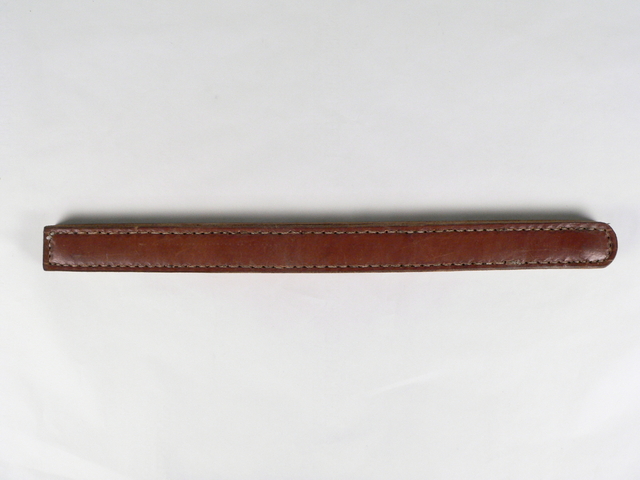by Adele on 14 December, 2010
This leather strap was made by William ‘Bill’ Brennan when he was aged in his 50s as a copy of the ones he made as a boy in the leather workshop of Clontarf Christian Brothers Home. Bill made the strap as a ‘witness’ to his experience in the Homes and gave it to Bruce Blyth, who was an early researcher of the history and advocate for former inmates of the Western Australian Christian Brothers Homes.

Bill Brennan, along with his brother Anthony, spent most of his childhood in the Christian Brothers Homes. He was in Clontarf from 1945 to 1952. Unlike most of the other inmates, these boys were not former Child Migrants but local Australians. His parents suffered mental illness and were unable to care for their children.
At the age of about 12, Bill’s schooling finished and he was set to work in the leather workshop of Clontarf. One day one of the Brothers asked to make him a strap. He had detailed instructions for it, including that it should contain a section of band saw and a lead pellet. Other orders followed, each with their own instructions. Bill remembers having made about 20 straps, of which 12 were accepted. Bill then had to watch his fellows being beaten with the straps he had made.
The task ended when a lay staff member arrived at Clontarf and was appalled that a boy should be required to make these items.


Christian Brother Barry Coldrey, in his book “A Most Unenviable Reputation” (1991) refers to the instructions given by the headquarters in Ireland (and at the time, of the world) of the Christian Brothers as to the dimensions of the straps to be used and as to where in Dublin they can be purchased. Bill Brennan’s experience with the strap is referred to in the VOICES’ (Victims of Organised Cruelty, Exploitation and Survivors) submission to the UK Health Committee.
The Ireland Commission to Inquire into Child Abuse (https//www.engaged-zen.org/PDFarchive/Commission_to_Inquire_into_Child_Abuse_Vol_I_Ch_6.pdf) mentioned in paragraph 6.213 the Christian Brothers rule laid down in their 1920 Chapter (6-yearly world-wide meeting)..
6.213 The 1920 Chapter was even more specific. It set down guidelines for
corporal punishment which included the advice that it should not be
administered within one hour of starting or finishing school and that numbers of
boys should not be punished at the same time. It stated that:
the strap … shall not exceed 13 inches in length; 1¼ in width and ¼
inch in thickness; in junior schools the strap is to be of smaller
dimensions
of all the books that have been prinrted i find ithard to understand where such stories come from i do recall the stap heave atthe end that was to hit your hand .at no time did i ever recall a brother abusing anyone sexually i lived at casteldear and clontarf from 1952 to 1960.
a number of us lads had a great time always in trouble and canned for it, it was all part of growing up one woud expect to be punished if cought as i did often but at the same time we had a lot of fun.
my book NO TIME TO CRY is about the good times we had in the orphanage there was a lot of good times all year round..
it was the child welfare who let us dowm.
cheers AP Rryan no 134